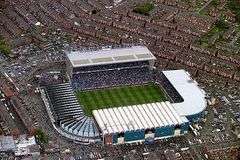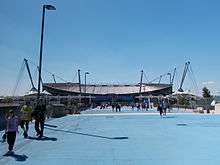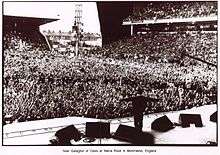Maine Road
| The Wembley of the North[1] | |
|
Aerial view of Maine Road on 11 May 2003, the day of the final match | |
| Location | Moss Side, Manchester |
|---|---|
| Owner | Manchester City F.C. |
| Capacity |
35,150 (at closing) 84,569 (maximum)[2] |
| Construction | |
| Built | 1923 |
| Opened | 1923 |
| Renovated | 1931,[3] 1957, 1970, 1994 |
| Expanded | 1935 |
| Closed | 2003 |
| Demolished | 2004 |
| Construction cost | £100,000[4] |
| Architect | Charles Swain |
| Structural engineer | Sir Robert McAlpine |
| Tenants | |
|
Manchester City (1923–2003) Manchester United (1945–1949) Events 18 FA Cup semi-finals 1 Football League Cup Final 4 Charity Shield matches 11 Rugby League Championship finals | |
Maine Road was a football stadium in Moss Side, Manchester, England, that was home to Manchester City F.C. from 1923 to 2003. It hosted FA Cup semi-finals, Charity Shield matches, a League Cup final and England matches and, because of its high capacity, gained the nickname Wembley of the North.[1] Maine Road holds the record for the highest attendance for a club in their normal home stadium, in English club football, set in 1934 at an FA Cup Sixth Round match between Manchester City and Stoke City.
By Manchester City's last season at Maine Road in 2002–03, it was an all-seater stadium with a capacity of 35,150 and of haphazard design with stands of varying heights due to the ground being renovated several times over its 80-year history. The following season Manchester City moved to the City of Manchester Stadium in East Manchester, a mile from the city centre and near Ardwick where the club originally formed in 1880.
History
Decision to move
Plans to build Maine Road were first announced in May 1922, following a decision by Manchester City F.C. to leave their Hyde Road ground, which did not have room for expansion and its main stand had been severely damaged by fire in 1920.[5]
Two sites in Belle Vue, East Manchester were suggested, but neither was deemed sufficient.[6] To many City fans east Manchester was regarded as City's home and a move to Belle Vue seemed right. But the site was just 8 acres (32,000 m2) and an available lease of 50 years was deemed too short by the club,[7] so it was decided that City would move to Moss Side. The move to a larger stadium at Maine Road was backed by then manager Ernest Mangnall.[8]
Many were disappointed when a site in south Manchester was chosen. A City director, John Ayrton, resigned from the Board later in the decade and helped to form a breakaway club, Manchester Central F.C., which played at Belle Vue.[9]
Construction
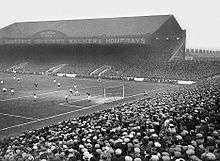
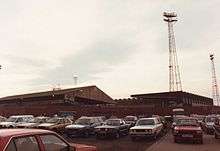
A sixteen and a quarter acre former brickworks on Maine Road was purchased for £5,500.[10] Maine Road was originally known as Dog Kennel Lane but renamed Maine Road (after the Maine law) during the 1870s at the insistence of the Temperance Movement[11] who owned land on Dog Kennel Lane and the local authority accepted their request.[12]
During construction, the stadium was reputedly cursed by a gypsy when officials evicted a gypsy camp from the area. This curse was allegedly removed on 28 December 1998.[13] However, the gypsy curse is likely to be an urban myth, as such stories are endemic to a number of football league grounds. Construction took 300 days, the total cost £100,000.[4] The initial layout of the ground consisted of one covered stand with a seating capacity of 10,000, and uncovered terracing on the other three sides, with gentle curves connecting the corners.[14]
Early years and record attendance
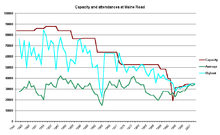
The first match at Maine Road took place on 25 August 1923 when 58,159 fans watched the home side beat Sheffield United 2–1.[15] The first changes to the ground took place in 1931, when the corner between the Main Stand and the Platt Lane end at the south of the ground was rebuilt to incorporate a roof.[3] This renovation was the first of many, as Maine Road's layout and capacity was varied throughout its lifespan.
In 1934, the second highest attendance at an English football game at a club ground was recorded at Maine Road. The first was the 1913 FA Cup Final, hosted by Crystal Palace with a crowd of 121,919. The Maine Road match was between Manchester City and Stoke City in front of 84,569 fans in the 6th round of the FA Cup on 3 March 1934.[16] Queues formed four hours before the match, and one journalist stated that Maine Road was packed two hours before kick-off.[16] A decision was taken to close the turnstiles with an attendance at approximately 85,000, 3000 short of what was thought to be the maximum capacity.[16] Supporters witnessed a visiting Stoke team which included Stanley Matthews and City's team boasted players, Frank Swift, Fred Tilson, Sam Cowan and Matt Busby.[16] The match was won 1–0 by Manchester City. This is the record home attendance for a domestic match and the record home attendance at a club ground (The 1913 FA Cup final is not considered a home match for either team).
Changes at the Platt Lane end took place in 1935, extending the terracing and providing a roof for the full stand. This marked the peak capacity of the ground, estimated at around 88,000.[17] Further changes were planned, but suspended when Manchester City were relegated from Division One in 1938, and abandoned when World War II broke out.[3]
Post Second World War
The stadium was shared by Manchester United after the Second World War as Manchester United's Old Trafford ground had been damaged during the Manchester Blitz. United paid City £5,000 per season, plus a share of gate receipts.[18] The highest attendance for a league game at Maine Road occurred during this period, when 83,260 people watched Manchester United play Arsenal on 17 January 1948. This figure is a national record for a league game.[19] Maine Road was also used by Manchester United, to host three of their four home games, in the 1956–57 European Cup.
1950s to 1980s
Floodlights were installed in 1953, and in 1957, prompted by the hosting of two FA Cup semi-finals in successive years,[20] the side facing the Main Stand (which until that time was generally known as the Popular Side) was redeveloped and named the Kippax Stand after a nearby street.[21] Over the course of the 1960s and 1970s, the Kippax became the part of the ground where the club's most vociferous fans congregated.[5] In 1963, benches were installed at the Platt Lane end, meaning that Maine Road had more seats than any other English club ground of the time.[21] The next major redevelopment came in the 1970s, with the construction of the North Stand, a cantilevered stand which remained in place until the closure of Maine Road. The 1980s saw ambitious plans for improvements: however, these plans were shelved due to financial pressures after the Main Stand roof had been replaced at a cost of £1 million.
Modernisation
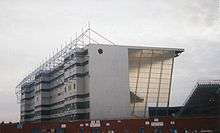
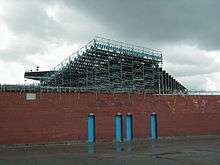
By 1990, some areas of the ground were becoming outdated, and there was the need for the stadium to become all-seater following the outcome of the Taylor Report in January that year, and the Platt Lane stand was demolished in 1992. Its place was taken by the all-seater Umbro Stand that also incorporated executive boxes, and was opened in March 1993. The stand's name was reverted to the Platt Lane Stand in the late 1990s.
The era of standing accommodation at Maine Road came to an end in May 1994 as the stadium became all-seater to comply with the requirements of the Taylor Report, with the demolition of the Kippax Street Terrace, which unusually for an all-standing area was located at the side of the pitch instead of behind the goals. The final match with standing permitted took place on 30 April 1994,[22] against Chelsea for a 2–2 draw. Immediately prior to demolition the capacity of the Kippax terrace was 18,300.[20] A three-tier stand was built in its place, holding nearly 14,000 spectators, and on its completion in October 1995 it was the tallest stand in the country, built at a cost of £16m in 1994, four times the turnover of the club according to then-chairman Francis Lee.[23] The revamp of the Kippax was the second phase of a five-part development plan that would have cost £40m[24] and increased the stadium's capacity to 45,024. However the club abandoned these plans as City were relegated from the Premier League in 1996 and from Division One two years later.[24]
The new stand was an impressive modern facility, but it also emphasised the haphazard nature in which the ground had been redeveloped, as all four sides were of differing heights and construction styles. There were further plans for expansion which would have taken the stadium's capacity to 45,000, but these were put on hold following City's relegation from the Premier League in 1996.
Final match and move to City of Manchester Stadium
There were plans for further expansion at Maine Road to take the capacity to an all-seated 45,000, but these were abandoned in favour of a move to the City of Manchester Stadium built for the Commonwealth Games in 2002.
The final competitive match before the closure of the stadium took place on 11 May 2003 with a Premiership match against Southampton. Tickets were sold upwards of £250[25] and a crowd of 34,957, about 100 off maximum capacity filled Maine Road for the final day.[26] City lost the match 1–0 with Michael Svensson scoring the stadium's last goal. The final match was followed by performances by musical acts Badly Drawn Boy and Doves.
City's final goal at the stadium was scored on 21 April 2003 by Marc-Vivien Foé during a 3–0 victory over Sunderland. Forty-five days later, the player died on 26 June from an undetected heart condition while representing the Cameroon national football team during the 2003 Confederations Cup.[27]
An auction of the ground's fixtures and fittings took place in July 2003, raising £100,000, which was donated to community projects in the Moss Side area, which was undergoing a lengthy regeneration process.[28] The two penalty spots and the centre spot were thought to be the most desired mementos, but all three had been cut out from the grass before the auction took place.[29] The auction lasted for seven hours and 1,000 supporters attended the auction with interest from clubs such as Preston North End and Norwich City for the bigger lots which could be reused.[30]
Redevelopment plans
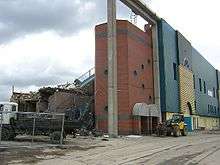
Towards the end of Maine Road's lifespan there were proposals for other sports teams to make use of the stadium following City's relocation; Stockport County once expressed interest in moving there from Edgeley Park,[19][31] and in December 2000 Sale Sharks rugby union club was offered a lease for the stadium.[32] However, none of the proposals came to fruition and some past City players stated their dismay at the stadium not being renovated for mixed-use sport stadium.[33] Demolition began in late 2003,[34] lasting around ten months.[35]
Two years later the go-ahead was given for a new housing development to take part on the site, consisting of 474 homes.[36] There is a public art display commemorating the stadium and features a circular plate half open, symbolising the centre spot and the new emerging development which now sits on the Maine Road stadium.[37][38]
Pitch
For long periods of its history Maine Road had the widest pitch in England. However, the width was changed several times by managers wishing to alter the pitch size to suit their style of play. In the final season before the ground was closed, the pitch size was 107 x 71 metres (116.5 x 78 yards). Maine Road's replacement, the City of Manchester Stadium has maintained this tradition of having a large pitch.
Other uses
| # | Date | Winner | Score | Loser |
|---|---|---|---|---|
| 1 | 1928 | Huddersfield Town | 1–0 | Sheffield United |
| 2 | 1946 | Derby County | 4–1 | Birmingham City |
| 3 | 1947 | Burnley | 1–0 | Liverpool |
| 4 | 1950 | Liverpool | 2–0 | Everton |
| 5 | 1951 | Blackpool | 0–0 | Birmingham |
| 6 | 1953 | Bolton Wanderers | 4–3 | Everton |
| 7 | 1954 | Preston North End | 2–0 | Sheffield Wednesday |
| 8 | 1958 | Bolton Wanderers | 2–1 | Blackburn Rovers |
| 9 | 1960 | Blackburn Rovers | 2–1 | Sheffield Wednesday |
| 10 | 1973 | Leeds United | 1–0 aet | Wolverhampton Wanderers |
| 11 | 1975 | Fulham | 1–0 | Birmingham City |
| 12 | 1977 | Liverpool | 2–2 | Everton |
| 13 | 1977 | Liverpool | 3–0 | Everton |
| 14 | 1979 | Manchester United | 2–2 | Liverpool |
| 15 | 1985 | Manchester United | 2–1 | Liverpool |
| 16 | 1990 | Manchester United | 3–3 | Oldham Athletic |
| 17 | 1990 | Manchester United | 2–1 | Oldham Athletic |
| 18 | 1994 | Manchester United | 4–1 | Oldham Athletic |
Maine Road hosted two England internationals, the first was a 3–0 defeat of Wales on 13 November 1946 and the second a 9–2 win over Northern Ireland on 16 November 1949, England's first ever World Cup qualifier. In addition, a number of wartime internationals were held at the ground. Maine Road was also the venue for a number of rugby league matches, hosting the rugby league championship final eleven times between 1938 and 1956.[19] It also hosted the Rugby League match of the cross code challenge between Wigan Rugby League and Bath Rugby Union.
Maine Road hosted Manchester United's first three home games of the 1956–57 European Cup, as Old Trafford didn't have floodlights installed and so wasn't deemed suitable to host matches in the tournament. The first European match at the ground saw United thrash Belgian champions RSC Anderlecht 10–0 in the preliminary round, a competition record which lasted for 17 years.[39]
It hosted many FA Cup semi-finals, the last being in April 1994 when Manchester United beat Oldham Athletic 4–1 in a replay.[40] It hosted the 1984 Football League Cup final replay, which Liverpool won 1–0 against Everton.[41]
The stadium was used for several scenes in the 1948 motion picture Cup-tie Honeymoon. More recently, it was featured in the 2000 film There's Only One Jimmy Grimble[42] and the 2003 ITV drama The Second Coming, which starred Christopher Eccleston.[43]
The stadium has hosted concerts by many famous artists, including Bryan Adams, Bon Jovi, David Bowie, David Cassidy, Dire Straits, Fleetwood Mac, Guns 'N Roses, Jean Michel Jarre, The New Power Generation, Oasis, Pink Floyd, Prince, Queen, The Rolling Stones, Simple Minds and Mavis Staples, among others. The most high profile concert held at Maine Road was that of Mancunian band Oasis (themselves avowed Manchester City fans) in April 1996, a performance which was later released as a video, ...There and Then.
Maine Road Football Club
Maine Road also gives its name to a non-league football club, Maine Road F.C. The club, who currently play in the North West Counties Football League Division One, was founded by a group of Manchester City supporters in 1955.[44] The club previously based its headquarters at the social club adjoining Maine Road.
References
Footnotes
- 1 2 "Maine Road through the ages". BBC Sport. 11 May 2003.
Known as 'The Wembley of the North', an 80,000 capacity meant it was the second biggest ground in the country, behind only Wembley.
- ↑ "Maine Road". mcivta.com. Retrieved 17 August 2011.
Estimate
- 1 2 3 Manchester City: The Complete Record, p91
- 1 2 Penney, Ian (1995). The Maine Road Encyclopedia. Edinburgh: Mainstream. ISBN 1-85158-710-1. p127
- 1 2 "Stadium history". Manchester City official website. Archived from the original on 20 February 2007. Retrieved 24 June 2007.
- ↑ James, Gary (2003). Farewell To Maine Road: The Official History of Manchester City's Grounds. Leicester: Polar Publishing. ISBN 1-899538-19-4. pp 35–46
- ↑ Murray, Chris (2000). Attitude Blue: Manchester City F.C. and P.L.C. Manchester: Chris Murray Publications. ISBN 0-9520520-9-1. pp 8–9
- ↑ James, Gary (2008). Manchester – A Football History, pp. 380–385 & 396–401.
- ↑ James, Gary (2008). Manchester A Football History. Halifax: James Ward. ISBN 978-0-9558127-0-5. Chapter 12: For The Good of Manchester?, pp 147–166
- ↑ James, Gary (2006). Manchester City – The Complete Record. Derby: Breedon. ISBN 1-85983-512-0. p89
- ↑ Collins, Nick (28 January 2011). "The temperance movement". The Telegraph. Retrieved 24 August 2011.
- ↑ James, Gary (2009). The Big Book of City. Halifax: James Ward. ISBN 978-0-9558127-2-9., pp 225–228
- ↑ James, Gary (2003). Farewell To Maine Road: The Official History of Manchester City's Grounds. Leicester: Polar Publishing. ISBN 1-899538-19-4. pp 44–45
- ↑ Everything under the blue moon, p135
- ↑ Manchester City: The Complete Record, p324
- 1 2 3 4 James, Gary (22 April 2011). "FA Cup special: Thrills, spills and a cast of thousands at Maine Road". menmedia.co.uk. Archived from the original on 12 November 2012. Retrieved 23 April 2011.
- ↑ Manchester City: The Complete Record, p93
- ↑ Inglis, Simon (1987). The Football Grounds of Great Britain (2nd ed.). London: Collins Willow. ISBN 0-00-218249-1. p63
- 1 2 3 Bevan, Chris (11 May 2003). "BBC Sport – Maine Road through the ages". BBC News. Retrieved 24 June 2007.
- 1 2 "The Kippax Last Stand". Manchester City v Chelsea match programme. 30 April 1994.
- 1 2 Waldon, Andrew (2003). Waiting for the Whistle: Manchester City's Last Season at Maine Road. Stroud: Tempus. ISBN 0-7524-3055-6. p9
- ↑ Waiting for the Whistle, p10
- ↑ "Lee: City can start trophy hunt". menmedia.co.uk. 6 September 2010. Retrieved 6 September 2010.
- 1 2 "Maine Road 1999". mcivta.com. Archived from the original on 5 September 2010. Retrieved 6 September 2010.
- ↑ Hattenstone, Simon (10 May 2003). "Shock and horror, but most of all relief". The Guardian. Retrieved 25 August 2011.
- ↑ "Saints spoil Maine Road party". BBC. 11 May 2003. Retrieved 25 August 2011.
- ↑ "Foe's death stuns football". BBC. 25 June 2003. Retrieved 28 August 2011.
- ↑ Various authors (2006). Power, Corruption and Pies Vol. Two. London: WSC Books. ISBN 0-9540134-8-4. p234
- ↑ MacKay, Duncan (12 July 2003). "City whitewash for spot of bother". The Guardian. Retrieved 25 August 2011.
- ↑ "Fans claim a slice of Maine Road history". The Telegraph. 13 July 2003. Retrieved 28 August 2011.
- ↑ "Stockport eye Maine Road move". BBC Sport. 30 November 2000. Retrieved 24 August 2011.
- ↑ "Sale step closer to Maine Road". BBC. 4 December 2000. Retrieved 24 August 2011.
- ↑ Bevan, Chris (11 May 2003). "Powerful Maine Road memories". BBC.
- ↑ "Bulldozers to move into Maine Road". Manchester Evening News. 24 October 2003. Retrieved 24 August 2011.
- ↑ "Sea of rubble at the end of the Road". Manchester Evening News. 19 April 2004. Retrieved 28 August 2011.
- ↑ "Transfer to Maine Road". Manchester Evening News. 2 March 2007. Retrieved 17 August 2011.
- ↑ "*Video* Maine Road As It Was & How It Looks Now". manchestercity.vitalfootball. 18 June 2010.
- ↑ "Striking design marks Maine Road spot". Manchester City Council. 24 June 2010. Retrieved 28 August 2011.
- ↑ Marshall, Adam (26 September 2011). "On this Day: United beat Anderlecht 10-0". Manchester United F.C. Retrieved 15 March 2013.
- ↑
- ↑
- ↑ "Famous TV & Film Moments at Maine Road". manchestercity.vitalfootball.co.uk. 25 January 2011.
- ↑ Bates, Stephen (25 January 2003). "Son of God, the Maine man". The Guardian. Retrieved 25 August 2011.
- ↑ "Derby day for fans' clubs". Manchester Evening News. Retrieved 24 June 2007.
Bibliography
- James, Gary (2003). Farewell to Maine Road. Leicester: Polar. ISBN 1-899538-19-4.
- Cummins, Kevin (2003). We're not really here: Manchester City's final season at Maine Road. London: Dazed. ISBN 1-904688-00-4.
- James, Gary (2008). Manchester: A Football History. Halifax: James Ward. ISBN 978-0-9558127-0-5.
- James, Gary (2009). The Big Book of City. Halifax: James Ward. ISBN 978-0-9558127-2-9.
- Inglis, Simon (1987). The Football Grounds of Great Britain (Second ed.). London: Collins Willow. ISBN 0-00-218249-1.
- Clayton, David (2002). Everything under the blue moon: the complete book of Manchester City FC – and more!. Edinburgh: Mainstream publishing. ISBN 1-84018-687-9.
External links
| Wikimedia Commons has media related to Maine Road. |
- "The Stadium Guide – Maine Road". Retrieved 27 July 2005.
- "BBC Sport – Saints spoil Maine Road party". BBC News. 11 May 2003. Retrieved 27 July 2005.
- Aerial view from 1923 - from the English Heritage "Britain from Above" website. Retrieved 6 May 2013.
Coordinates: 53°27′4″N 2°14′7″W / 53.45111°N 2.23528°W
